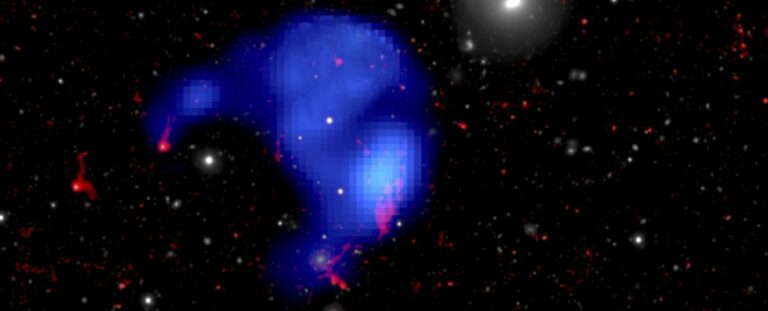Astronomers have made a remarkable discovery – a colossal cosmic cloud that surpasses the size of the entire Milky Way.
Where there is boundless emptiness between the stars, there is something out there that is unknown. They said it is not a galaxy but a giant gaseous nebula, which is even bigger than the Milky Way Galaxy. It is even diffused and this gigantic cloud has formed a single large association in the interstellar space.
Oddly enough, this is the only cloud of this kind that has ever been spotted by the scientific community. In their opinion, it was apparently ripped off from a galaxy within a particular cluster. More intriguing is the fact that this cloud has not dispersed even after hundreds of millions of years but is well compacted.
This groundbreaking discovery unveils a new way of studying these gigantic structures and getting insights into the operations of clusters of galaxies.
Certainly, this discovery can be considered quite surprising and inspiring at the same time. The oldest science, astronomy, always has its surprises in store, as the particle physicist Ming Sun from the University of Alabama in Huntsville highlighted.
In view of this, the term galaxy clusters refers to systems of galaxies that are bound together by gravitational forces. Our “orphan” gas cloud was found in the Leo Cluster or, to be precise, in Abell 1367 cluster, located about 300 million light years away. Include at least 72 bright galaxies, which make it an important part of a large-scale complex of superclusters.
They are attracted to regions filled with action as they contain helpful information on the state within the context of the interconnection of the universe. Further, in the course of the year 2017, Abell 1367 was observed using Subaru Telescope in Japan. It started as an imperceptible spherical structure emitting warmth in space and of unidentified genesis, investigation to follow.
For further investigation of this wonderful phenomenon, the team which was headed by the distinguished astronomer Chong Ge of the University of Alabama in Huntsville employed Subaru, Multi Unit Spectroscopic Explorer (MUSE) of the Very Large Telescope and the X-Ray Multi Mirror mission-Newton spacecraft of the European Space Agency (ESA). Their work unearthed the shocking discovery that the cloud’s size was even bigger than had been estimated, further hinting at dimensions bigger than the Milky Way galaxy. This hinted at having a mass about 10 billion times that of the Sun. Strangely it appeared to be ‘floating’ more or less on its own, not belonging to any of the galaxies known in the particular cluster.
By accumulating such a rich amount of information, the researchers were able to establish the temperature of the gas in the cloud, which was essential in establishing the cloud’s origin. This was between 10,000 to 10,000,000 K, which correlated with the interstellar medium within galaxies. On the other hand, the gas which lies between the galaxies within the cluster is much hotter and it has a temperature of about 100 million Kelvin, which forms a very thin layer of hot gas.
This means that the gas cloud has been torn from a galaxy as the latter moved along the Universe space. The hot gas present in the cluster first exert pressure on the cloud through what is referred to as the ram pressure and as a result, the gas in the cloud is stripped. This occurs when the host galaxy migrates through the hot gas at velocities between 1, 000K and 2, 000K, according to Sun.
Seyfert and other galaxies with a cloud torn off from the disk and evaporating its mass in the ICM might be compared to the feeling of hair and clothes flying backward when running against the headwind. It is also important to note that this isolated cloud has been recently discovered and does not contain any G objects surrounding it, which makes researchers interested but baffled. Their relative isolation from other galaxies indicates the intracluster medium gaseous component was “stolen” from its galaxy several billion years ago, with questions arising as to how the Superbubble has stayed intact in the medium.
Working out the numbers, the team discovered that a magnetic field could have extended the cloud’s strength long enough to resist the instabilities that threatened its cohesiveness. It means that the cloud is massive and was formed from a massive and bigger parental galaxy, which can be fishe out further. Any such gas leakage that may be taking origin from the cloud may also be of great help in understanding the origin of the galaxy, its origin galaxy.
It would be useful to find such a cloud in the future in order to investigate phenomena similar to it that would add to the understanding of the distribution of ‘matter’ in the galaxy cluster and internal dynamics in the region. Of course, it is also possible for galaxies to lose their gas to the intracluster medium, and there is, surprisingly, observational evidence for this.
Dr Sun, the leader of the research, also pointed out the importance of this revelation, pointing to the possiblity to identify other clumps of gas in the intracluster medium when using wide-field optical surveys (Dr. Sun, private communication, 2nd February, 2015). Said findings are articulated in the Monthly Notices of the Royal Astronomical Society, a highly reputable journal.
Do not forget to share your opinion with us to provide you with the best posts !




0 Comments